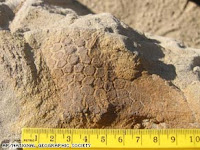SKIN of DINOS

The discovery of fossilized remains of an hadrosaur (Dinosaur, that eat plants, 12 m of long, 3,5 tons weight. 67 million years, found in North Dakota/USA), preserving great part of its skin, ligaments, muscles, tendons and perhaps internal organs, offers to carry us toward a better functional knowledge of these animals, but mainly toward the final objective: clonation of dinos, starting from nuclei/cell remains. For the present it is inferred that: I) this dino, ran but quick (45 km/h), than the predator Tyrannosaurus rex. (32 km/h), when possessing haunches and legs 25% but big (determined by a scan of great scale), of what was thought (Phillip Manning/University of Manchester/UK). II) Although one doesn't know the color of the skin, in the monochrome bottom of its epidermis, there are patterns of big and small bandages, over which scales of varied sizes are superimposed, as those observed in the skin of modern reptiles, almost always associated to transitions of different colors. Thanks to the intact texture of the skin, additional bandages patterns have been discovered, especially in joint areas of the arms.
The experts say that armored dinosaurs (with thorns and protuberances), fossilized their skin with easiness, whenever they dies in dry places, where the environment turned quickly its skin in hard and leathery. For the case of this hadrosaur it is thought that acidity and muddy water collected in its surroundings, favored the deposit of minerals and trapping of organic molecules, preserving the tissues before its decay. Some current reptiles, as the small lizard, have scales that are overlapped as the tiles of a roof, as long as others maintain their scales united as the tiles of a bathroom. Surprises are expected in the color of the skin of dinosaurs as long as some current reptiles exhibit brilliant colors, to hide or to attract the couple. It is possible that the skin of dinosaurs presents drawings and colors to camouflage. III) Varied scans shows ear vertebras enough spaced, what means that they possessed tails but big of what was thought. IV) if remains of internal viscera are found, it will be possible to identify fossilized biomolecules and perhaps, proteins traces. At the beginning of this year it was announced the discovery of collagen in remains of T. Rex, seating the theory that birds, descend from dinosaurs.
PIEL de DINOSAURIOS VEGETARIANOS
El hallazgo de los restos fosilizados de un hadrosaurio (Dinosaurio, come-plantas, 12 m de largo, 3,5 ton de peso. 67 millones de años, hallado en North Dakota/USA), conservando gran parte de su piel, ligamentos, musculos, tendones y tal vez órganos internos, ofrece conducirnos hacia un mejor conocimiento funcional de estos, pero sobre todo hacia el objetivo final: la clonación de los mismos, a partir de remanentes nucleo/celulares. Por de pronto se infiere que : I) este dino, corria mas rapido (45 km/h), que el predador T. rex. (32 km/h), al poseer ancas y piernas posteriores 25 %, mas grandes y musculosas (determinadas por un scan de gran escala), de lo que se pensaba (Phillip Manning/University de Manchester/UK). II) Aunque no se conoce el color de la piel, en el fondo monocromo de su epidermis, se aprecian patrones de rayas grandes y pequeñas, sobre las que se superponen escamas de variados tamaños, semejantes a las observadas en la piel de modernos reptiles, asociadas casi siempre a transiciones de diferentes colores. Merced a la textura intacta de la piel, se han descubierto adicionales patrones a rayas, especialmente en las areas articulares de los brazos.
Los expertos opinan que los dinosaurios acorazados (espinas y protuberancias), fosilizaban su piel con facilidad, siempre que muriesen en lugares secos, donde el medio tornaba rápidamente su piel en dura y correosa. Para el caso de este hadrosaurio se piensa que los sedimentos de agua acida y cenagosa colectadas a su alrededor, favorecieron el rapido deposito de minerales y atrapamiento de moléculas organicas, preservando los tejidos antes que se pudriesen. Algunos reptiles actuales, como la lagartija, tienen escamas que se solapan como las tejas de un tejado, en tanto otros mantienen sus escamas unidas, como los azulejos de un cuarto de baño. Se esperan sorpresas en el color de la piel de los dinosaurios en tanto algunos reptiles actuales exhiben colores brillantes, para esconderse o atraer a la pareja. Es posible que la piel de los dinosaurios presentase dibujos y colores, para camuflarlo. III) Variados scans muestran las vertebras de la cola del dinosaurio bastante espaciadas, lo que significa que poseían colas mas grandes de lo que se pensaba. IV) si se encontrasen restos de visceras internas, será posible identificar biomoleculas no fosilizadas y tal vez, trazas de proteinas. A principios de año se anuncio el descubrimiento de colagena en restos de T. Rex, asentando la teoría de que las aves, descienden de los dinosaurios.
Labels: dinosaurs



.+Photo+Author.jpg)



0 Comments:
Post a Comment
<< Home